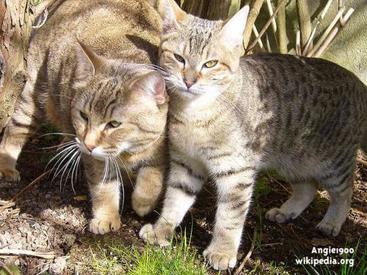
The Pixie Bob originates from...
It is generally accepted that this breed emerged as the result of a chance mating in 1986 between a Bobcat and a Domestic Shorthair. This large, 17lb Bobcat was owned by Carol Ann Brewer of Washington State, who kept one of the resulting offspring from this mating and named it ‘Pixie.’ Brewer soon fell in love with the appearance of the cat and began a selective breeding program to try and retain its unique characteristics. Pixie became the original breeding stock for the Pixie Bob, which is now recognised as an independent breed by the International Cat Association as of 1994, and the American Cat Fanciers Association 11 years later.
The Pixie Bob is characterised by...
Many people compare the Pixie Bob to the North American Bobcat because of its stocky build. It is further characterised by a rectangular body, black-tipped ears, long, nimble legs, a stumpy tail, hooded eyes, and polydactyl paws. Typically, a Pixie Bob will have up to seven toes on each foot. Unlike most breeds of cat that reach their full growth potential at one year, this breed can take up to four years to reach its full size. Short and long-haired variations are seen, although the short-haired is the most common. Either way, the coat boasts a spotted tabby pattern and is easy to maintain with regular grooming. These cats are also highly trainable and many owners report they are more like dogs than cats.
The average Pixie Bob...
The temperament is very desirable in a house cat — compatible with children and other pets, energetic, and sturdy enough to make a great playmate, this breed is well suited to domestic living in a family that returns its love and affection. It enjoys being included in activities around the home and does not appreciate being left alone for long periods of time. They are also exceptionally intelligent and can be trained to a good degree, being happy to stay indoors when there are interactive toys and scratching posts available. When it comes to the size of a Pixie Bob, there are large discrepancies across gender. A female will usually weigh up to 12 pounds, while a male Pixie-bob can weigh up to 20. The average life expectancy for this breed is 15 years.
Weaknesses...
The Pixie bob is fairly rare and therefore any genetic or breed-specific health conditions are difficult to determine. It is generally considered a very healthy and resilient breed, despite being sensitive to some vaccinations.
Browse more breed facts and information or take a look at our range of our cat toys and scratching and climbing posts.
Do you own a Pixie-bob? Let others know what they're like!
Related products
Advantage 80 Spot On Flea Control Large Cats and Rabbits
from £10.89
Advantage 40 Spot On Flea Control Cats, Small Dogs and Rabbits
from £10.89
Advantage 100 Spot On Flea Control Medium Dog
from £10.89
Drontal Tasty Bone Wormer Tablets for Small & Medium Dogs (2 to 20kg)
from £1.83
Advantage 250 Spot On Flea Control Large Dog
from £10.89
FRONTLINE Plus Flea & Tick Treatment Dogs & Cats
from £17.49
TermaWorm™ Tablets for Cats & Dogs
from £1.59
Drontal Tasty Bone XL Wormer Tablets for Large Dogs (Over 20kg)
from £5.43